Any variant of the Orpington chicken breed is going to be a showstopper, but the Jubilee Orpington takes things to a different level. You may not have seen a Jubilee Orpington yet but you’re unlikely to forget these lovable beauties if you ever do.
Perhaps the most surprising thing about Jubilee Orpingtons is that they were only recently introduced to North America. These Orpingtons are already more than a century old and were even present during Queen Victoria’s time.
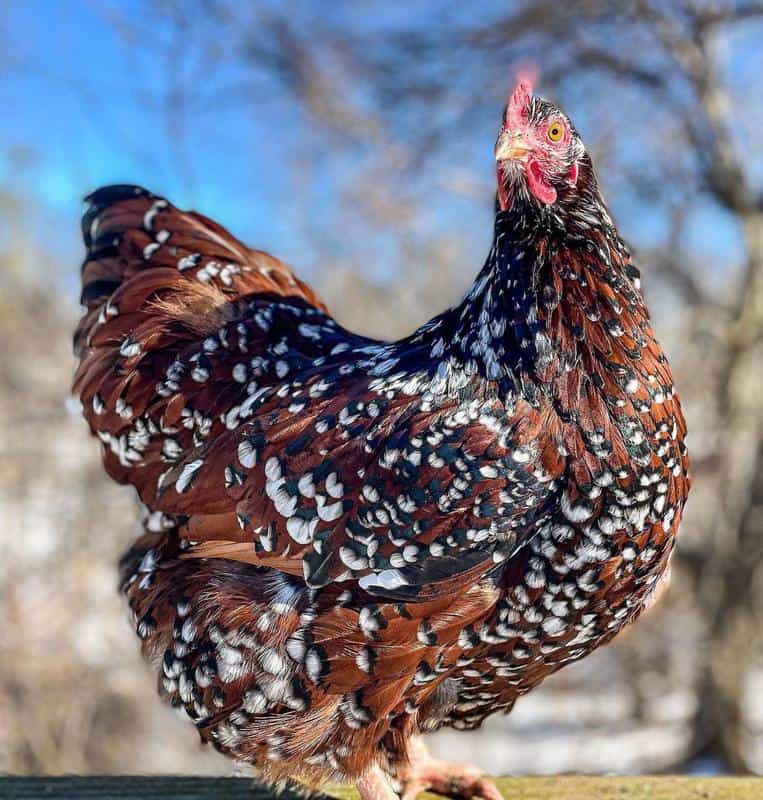
The Jubilee Orpington bears some resemblance to the Spangled Orpington but that could just be a coincidence. This variant has similar characteristics to the other members of the Orpington family including their egg production ability.
The unique appearance of Jubilee Orpingtons makes them well-suited for some climates but can be a problem in others. Their easy-going nature makes them easy to handle and potentially good pet chickens.
It’s only fair that a chicken this beautiful gets more headlines than it currently does. Read on to find out if the Jubilee Orpington is the right chicken for you today.
Jubilee Orpington Quick Facts:
| Names | Jubilee Orpington, Speckled Orpington |
| Origin | Orpington, England |
| Purpose | Meat, Eggs, and Exhibition |
| Egg Production/Year | 200 |
| Climate | Very cold hardy, heat tolerant with shade |
| Plumage Color | Light mahogany with black and white spots |
| Weight | Hens: 7.94 lbs.
Roosters: 9.9 lbs. |
| Personality | Friendly and Calm; not flighty |
| Unique Fact | Was named to mark Queen Victoria’s Diamond Jubilee. |
History of the Jubilee Orpington
Development
After he developed the original Black Orpington in 1886, William Cook continued to develop other color variants of the same breed. It is said that the Jubilee Orpington was introduced to the world in 1897, eleven years after the Black.
Lineage
To this day, nobody knows for sure what chicken breeds were used to develop this variant of the Orpington.
Some sources state that these chickens were the result of crossing Buff Orpingtons with Spangled Old English Game Chicken while others state that Dorking chickens were also involved.
Some other sources believe that Speckled Sussex chickens had to have been involved. The plumage of the Jubilee Orpington and the Speckled Sussex certainly share an undeniable similarity.
Jubilee Orpingtons’ Royal Connection
William Cook must have known he had developed something special. So much so that he named the new chicken Diamond Jubilee Orpington, later shortened to Jubilee Orpington.
It just so happened that on the year these Orpingtons were introduced to the world, Queen Victoria was marking her 60th year as queen. Fittingly, as part of the occasion, a flock of the newly developed chickens was given to the queen.
You would think that a royal connection would make this the chicken everyone wanted to have, but Jubilee Orpingtons never attained the popularity of the original, especially outside of England.
Jubilee Orpingtons were only introduced to North America sometime in the last decade and remain rare in the US today.
The Appearance of Jubilee Orpingtons
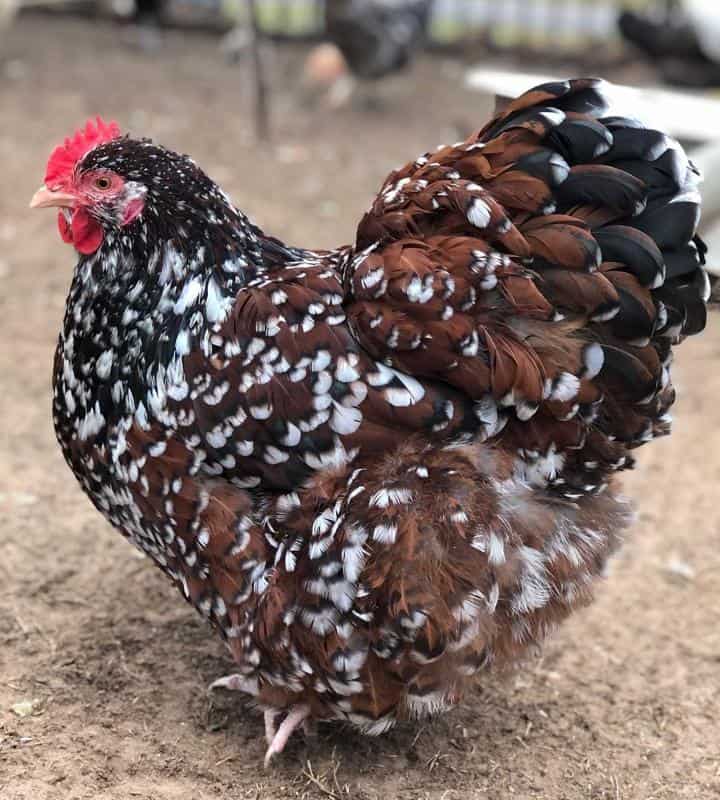
Body
The body of the Jubilee Orpington is like that of other Orpington chickens. They are broad and deep with a stocky appearance.
Their backs are concave, and their breasts are broad and round, while their tails are short, compact, and held high. The head of Orpingtons are small with large eyes, and small single combs.
Orpingtons have strong and short legs that are properly set apart. Ideally, the body feathers should cover their thighs.
Plumage
Like other Orpingtons, the feathering on the Jubilee Orpington is abundant. The feathers are soft and loose on the body.
However, the color pattern of the Jubilee Orpington is much more complex than that of other Orpingtons. The base color is a bright shade of mahogany, but the feathers also have black bands with white tips.
The three colors are distinct on the bird giving their plumage the look of a beautiful tapestry. It can take as many as 18 months before the coloration achieves its final look thus, don’t rule out a potential show bird early.
Size
Jubilee Orpingtons don’t just look hefty, they are larger than your average chickens.
According to UK show standards, the ideal rooster should be about 9.9 pounds while a mature hen should weigh approximately 7.94 pounds. Some of these chickens are reported to weigh as much as 14 pounds if given enough time.
Bantam Jubilee Orpington
In case you want to have everything the Jubilee Orpington has to offer but in a small package, you can get a Bantam Jubilee Orpington.
These Bantams are a little larger compared to others and can weigh over 4.5 pounds. Check out the flock of Bantam Jubilee Orpingtons in the video below.
What is the Purpose of Jubilee Orpington Chickens
Meat
The first thing you’re likely to think when you see a Jubilee Orpington, or probably any other Orpington, is that it probably has a lot of good meat on it. You would be right to think that.
Orpingtons were intended to be dual-purpose birds and the fact that they weigh 8 to 10 pounds when mature makes them excellent meat birds.
Due to their characteristics as heritage chickens, Jubilee Orpingtons are best cooked low and slow to avoid ending up with a tough chew of meat.
Eggs
Jubilee Orpington chickens will today give you as many as 200 large eggs in a year and they start laying after 24 weeks. This is quite good for a heritage breed in this age of hybrid layers.
The eggs from Orpingtons are usually light brown in color. However, the Jubilee Orpington’s eggs are known to be lighter than those of other Orpingtons and can even be cream-colored.
It’s possible that Orpingtons once had the capacity to keep up with today’s hybrid layers. It is said that in the early days, these hens could produce over 300 eggs in one year.
What could have happened to change this? This chicken’s other purpose may have something to do with it.
Exhibition
Soon after their development, it didn’t take long for enthusiasts to set their eyes on Orpingtons of all varieties. Today, Orpingtons are a well-known show breed.
It is said that as the emphasis for raising Orpingtons shifted from meat and eggs to exhibition, breeders started to select the chickens based on looks. This resulted in some very beautiful chickens but may have contributed to a decline in their egg-laying potential.
Jubilee Orpingtons are one of the Orpington varieties that are accepted for showing in the UK. However, since these birds never made it to the US until quite recently, it is not one of the color varieties that are recognized by the American Poultry Association.
Practical Tips for Raising Jubilee Orpington Chickens
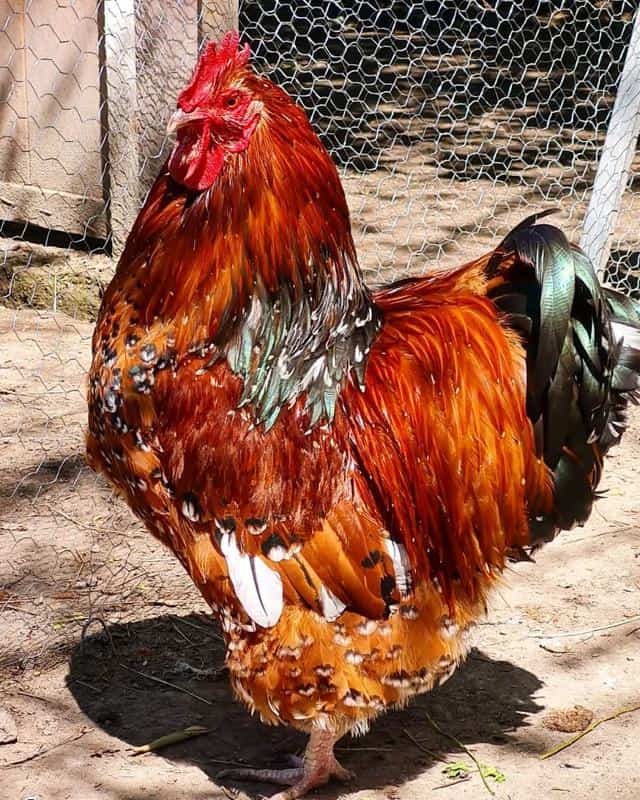
Environment and Housing Considerations
A stressful environment can affect the health and productivity of chickens. Due to the uniqueness of Orpingtons, you should consider the following when raising Jubilee Orpington chickens:
- Jubilee Orpingtons are cold hardy. The cold and short days of winter do nothing to keep the hens from laying regularly as their feathering keeps them warm enough.
- The same feathering that keeps your Orpingtons warm during winter can make things a little challenging in the summer. These chickens can tolerate hot days but will require shade from time to time.
- For a chicken this big and feathered, a little extra space in the coop goes a long way in keeping them more comfortable during summer. 8 square feet per bird should be the minimum but they won’t complain if you give them more.
- Despite their size, a 12 by 12-inch nesting box is perfectly okay for Jubilee Orpington hens. Although it may seem like this size box is too small for them, many farmers have found it works quite well.
- Although they are great at free-ranging, Jubilee Orpingtons can also tolerate confinement In confinement, ensure you provide a run so your Orpingtons get enough exercise as they can become overweight.
Diet
As a big, heavy bird, you may assume that Jubilee Orpingtons spend their days gorging themselves on feed. Although they certainly eat more food than smaller breeds, these birds were also developed to be practical to rear in an 1800s backyard.
Some of the things you should know about how these birds feed are:
- Like most other chickens, Jubilee Orpingtons should be fed commercial feeds that have been formulated to meet their purpose. This means a layer mash for hens being kept for eggs and broiler feed for those being kept for meat.
- Orpingtons were developed to be able to forage and will do so well when given the opportunity. If you have the space for it, free-ranging will allow your Jubilee Orpingtons to supplement their feed with whatever nature provides.
Temperament
One of the best things about Jubilee Orpingtons is their temperament. These chickens are quite friendly, and their cuddly appearance is more than just a look.
This personality makes these chickens great pets since they are friendly enough to interact with children. Jubilee Orpingtons are also not keen on flying due to their size.
Lifespan
If cared for properly, Jubilee Orpingtons will live for around 8 years. They also happen to be good meat birds, so many of these birds will be slaughtered long before then.
Companion Breeds
As big as they are, Orpingtons are, perhaps, too docile for their own good. They are prone to getting picked on by more assertive breeds in the coop.
To keep your birds stress-free, choose similarly friendly chicken breeds if you have a mixed flock.
Health Concerns When Raising Jubilee Orpingtons
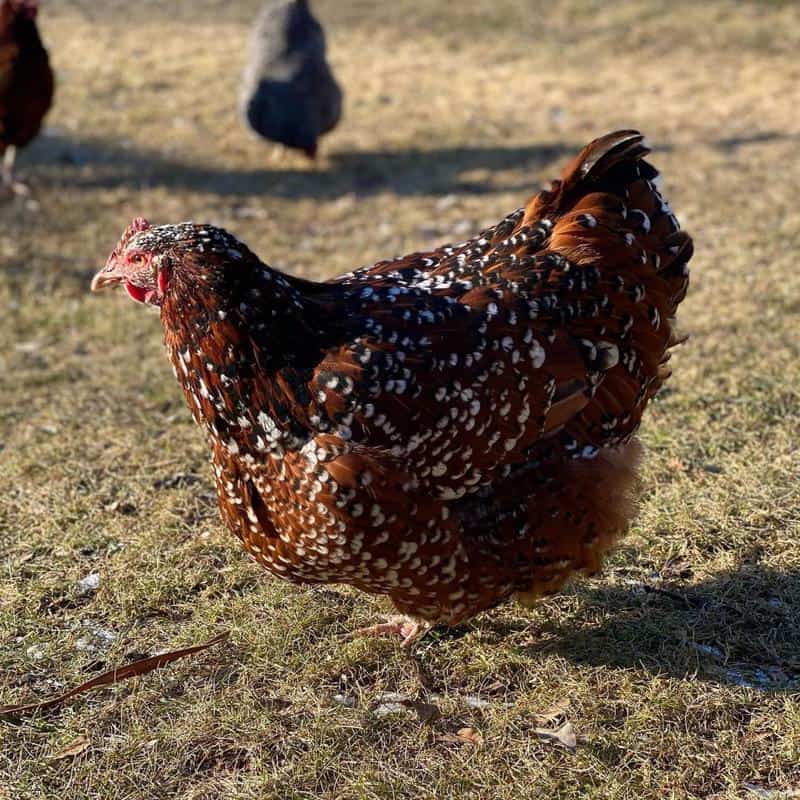
Jubilee Orpingtons, like many heritage breeds, are hardy and aren’t easily susceptible to diseases. However, their plumage creates two potential health issues you should be aware of.
Wet Feathers
The same feathers that keep your Jubilee Orpingtons warm in winter can be a nightmare if they get wet. Wet feathers will not provide protection from the cold and make your chickens susceptible to frostbite.
This situation is worse in Orpingtons because of how close to the ground their bodies and feathers are. Don’t let your Orpingtons walk around in the snow in winter and the run should ideally be covered.
Lice and Mites
Lice and mites love feathers and they are common chicken pests. The heavy plumage on Jubilee Orpingtons creates an ideal environment for these pests to make your chickens miserable if you allow them to.
Chickens know all about these pests and how to handle them in many cases. The solution is usually a dust bath, and you may see your chickens rolling around in some dirt every now and then.
Some farmers simply allow their chickens to take a dust bath wherever they feel like it. Others take the extra step of preparing a suitable dust bath complete with insecticidal dust among other things.
Either solution may work depending on your situation, but the first may not be practical in winter or when the ground is wet. Ensure that you inspect your Jubilee Orpingtons for these pests regularly and take aggressive measures if needed.
Breeding and Brooding in Jubilee Orpingtons
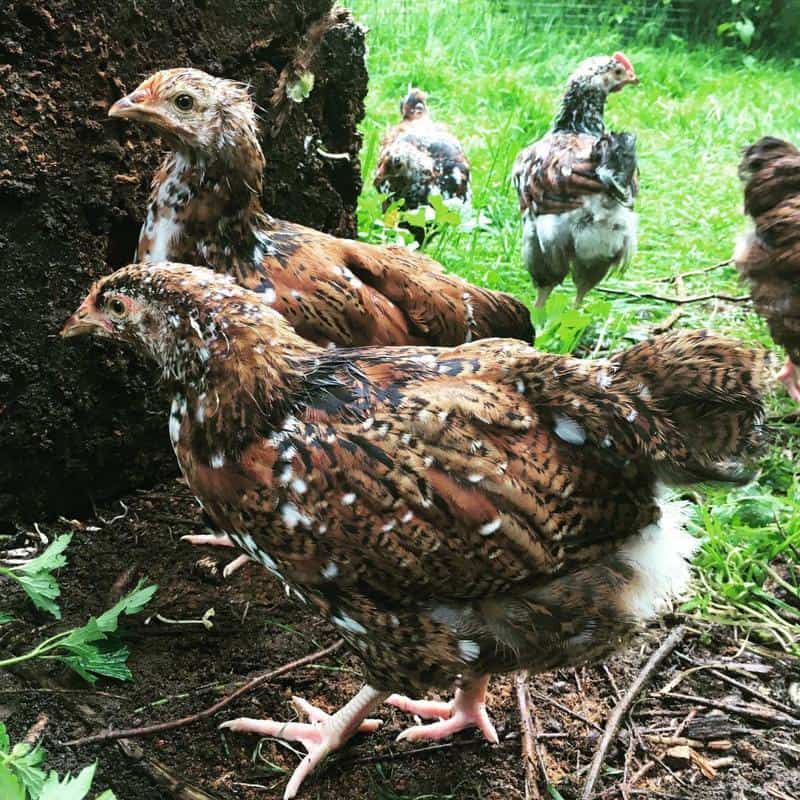
Jubilee Orpingtons are perfect if you’d like to raise chicks as well. These chickens are excellent mothers and regularly go broody, hatching their own chicks.
Jubilee Orpingtons are a true breed so if both parents are Jubilee Orpingtons, the chicks will be of the same breed too.
Read More:
Is a Jubilee Orpington Fit for You?
The Jubilee Orpington is a great all-round bird that can be used for meat, eggs, and exhibition. On top of that, they have an endearing personality that makes them great to keep as pets as well.
These chickens are larger than your normal birds, but they also come in a bantam variety, although these are a little harder to find.
Their size means they need a little more space, and perhaps they eat more than your typical chicken, but they are hardly complicated to raise. They don’t mind being confined and are also great at foraging.
The feathers on these birds keep them warm during the coldest winters but care must be taken to keep them from getting wet and to prevent pest infestations.
If you’re thinking about getting an easygoing bird that you’ll love to show off, you could hardly go wrong with a Jubilee Orpington.
